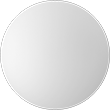High-Strength Fracture- and Wear-Resistant Zirconia Ceramic Balls

- Color: White
- Temperature Range: See table
- Fabrication: Sintered
- Porosity: See table
- Compressive Strength: See table
Often used instead of metal in bearings and rollers, these balls are ideal for applications where strength under heavy loads and wear resistance is needed. It's the addition of yttria that gives this zirconia more strength and lowers the chances of cracking from impact than standard zirconia, alumina, and silicon nitride ceramic. If cracks do occur, they will not spread, extending the life and reliability of the material. It also means this zirconia blend resists wearing down from rubbing against another part or abrasion from chemical slurries.
These balls do not withstand rapid temperature changes or high temperatures as well as other high-performance ceramics such as alumina and silicon nitride ceramic.
| Diameter | Diameter Tolerance | Minimum Temperature | Maximum Temperature | Compressive Strength, psi | Porosity | Pkg. Qty. | Pkg. | |
| 25mm | -2.50000mm to 2.50000mm | Not Rated | 1000° F | 300,000 | Not Rated | 1 | 0000000 | 000000 |
Nonporous Alumina Ceramic Balls

- Color: White
- Max. Temperature: 2000° F
- Fabrication: Fired
- Porosity: Not Rated
- Compressive Strength: 300,000 psi
Seal out air and gas in high-temperature and high-wear applications. This ultrahard ceramic can also be used in applications that require superior strength.
| Dia. | Dia. Tolerance | Sphericity | Each | |
| 25mm | -0.0001" to 0.0001" | 99.99% | 0000000 | 000000 |


























